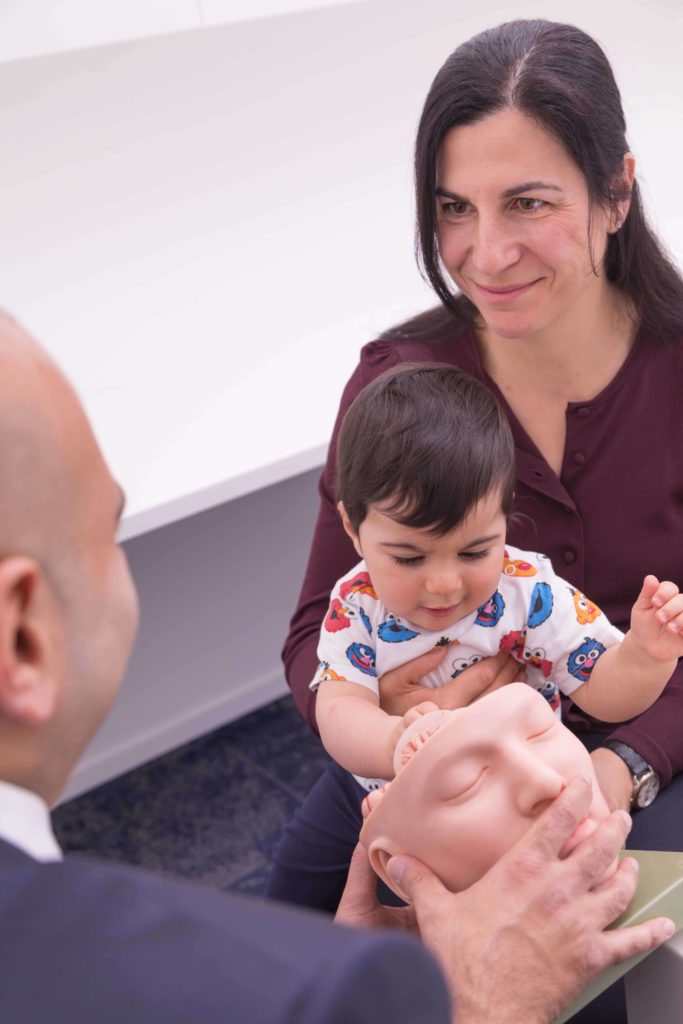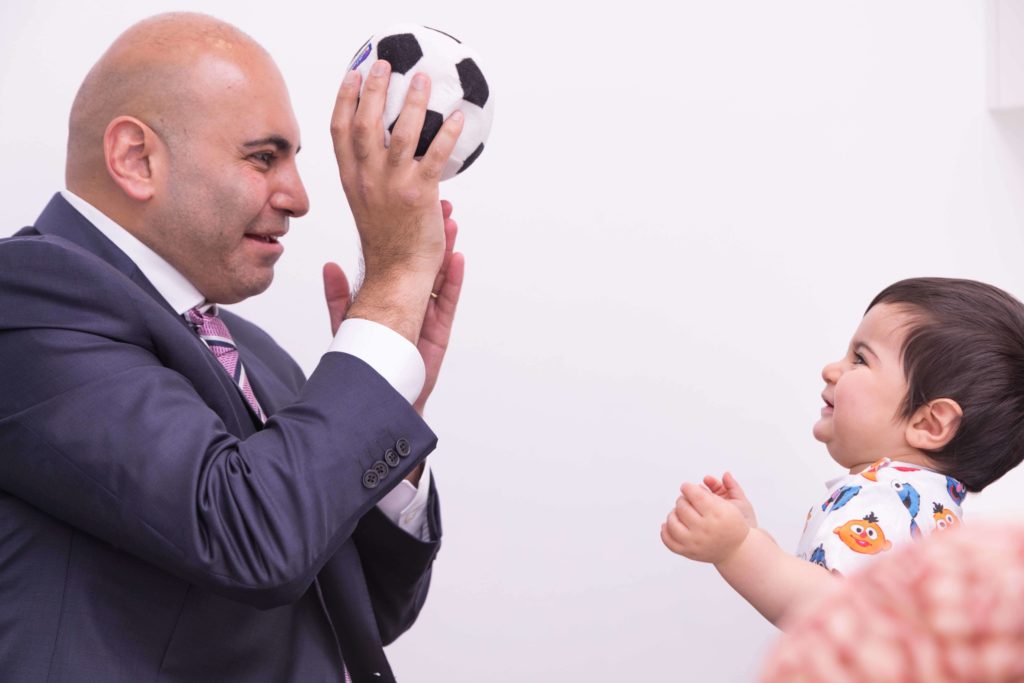Dr Bhatia provides caring advice and treatment for children and their families in a comfortable and safe environment.
ETHOS – Dr Bhatia
I am dedicated to ensuring children and their families dealing with a brain or body vascular malformation are treated in a comfortable and safe environment. Whether you choose to see me at Sydney AVM or at the Children’s Hospital at Westmead, you will receive my expert advice in a relaxed consultation where all your questions and concerns will be addressed. In addition, at the Children’s Hospital at Westmead, our service has a Clinical Nurse Specialist who you can provide additional support to you before and after treatment.
With three children of my own, I know the importance of consulting with a doctor who has dedicated his training and practise to treating children, and who treats my child and us as his parents with respect, support, and caring.
I am the only interventional neuroradiologist in Australia who undertakes regular working days and treatment lists at a children’s hospital. Whilst other INR practitioners may perform a ‘drop-in’ approach or undertake children’s procedures in the unfamiliar environment of an adult hospital, I am committed to ensuring that the children and families I treat have access to the full range of services available at Children’s Hospital Westmead. I undertake regular days at the children’s hospital because I believe your child deserves a doctor who will be there to support them before, during, and after treatment.

TREATMENT LOCATION
I admit to hospital most of my patients under my own bedcard/name at Children’s Hospital at Westmead, so that you know that my team and I will be dedicated to the care of your child. We have a Clinical Nurse Specialist in our team and I have two expert paediatric interventional radiologists that I work alongside (Dr Lord and Dr Chennapragada) – so there will always be someone you can contact if you have concerns.
At Children’s Hospital at Westmead, alongside my colleague Dr Lord, we undertake treatment of Vein of Galen Malformations in infants – a highly specialized procedure that should not be undertaken by someone who is not experienced in the procedure.
In addition, we have a comprehensive service for the management of vascular malformations and provide the highest level of care available in Australia for the treatment of complex vascular malformations in children.

TRAINING in PAEDIATRIC INR
I am the only interventional neuroradiologist in NSW who has undertaken dedicated training in paediatric INR procedures at an international world-renowned children’s hospital (The Hospital for Sick Children in Toronto, Canada). Communicating in a caring and supportive way with children and their families, understanding vascular conditions that affect children (which are very different to adult conditions), and having the fine and gentle technical skills needed to access and treat through children’s blood vessels are skills that require dedicated training. Make sure you child is treated by a doctor who has specialized training in treating children. Children should not be treated like ‘small adults’ by practitioners who usually treat adults only – their needs are unique, and they require specialized care.
Before you place your child in the hands of an INR practitioner, ask them where and how they were trained in paediatric neuro-intervention. Make sure they had training in a dedicated children’s hospital where they learnt specifically about the needs of children and their families.
Brain & Body Vascular Malformations
- VEIN of GALEN MALFORMATIONS
- BRAIN ARTERIO-VENOUS MALFORMATIONS (AVMs)
- HEREDITARY HAEMORRHAGIC TELANGIECTASIA
- FACE, NECK, and BODY VASCULAR MALFORMATIONS
Dr Bhatia has highly specialized expertise in the management of Vein of Galen Malformations (VOGMs), a rare and serious high-flow malformation of the blood vessels deep in the brain that affects newborn babies and infants. VOGMs can cause cardiac failure after birth, enlarged fluid spaces in the brain in infancy, and developmental delay later in childhood. Working in a team with his colleague Dr David Lord, Dr Bhatia can help you to understand the condition and the risks it poses to your baby, to help co-ordinate the care of your baby prior to, during, and after delivery, and to undertake the complex embolization procedures needed to reduce the flow in the malformation.
VOGMs are often diagnosed on third trimester ultrasound but sometimes are missed until after birth. If your third trimester ultrasound has shown that your baby has a VOGM, please arrange a consultation with me at Sydney Aneurysm so we can organize care for your child. Most often we will ask your obstetrician to arrange for a colleague of theirs to deliver your child at Westmead Hospital, after birth we will arrange admission for your baby to the Neonatal Intensive Care Unit at Children’s Hospital Westmead, we will perform an MRI to map the malformation, and we will then advise you if we think treatment is likely to be helpful (we usually offer treatment in around 3 out of 4 cases). Based on the degree of flow we decide on the timing of the first procedure – but often this is in the first week of life if there is concern for heart failure developing.
We aim to slowly bring down the flow in the VOGM over 3-5 sessions spaced over the first year of your baby’s life. Our aim is to slow down the VOGM to try and give your child the best chance of a good long-term outcome. Whilst we often cure the malformation, this is not our main goal – we aim for a good long-term neurological outcome. Unlike other vascular malformations in the brain, VOGMs are not known to bleed outside the setting of treatment-related complications. We aim to save your baby’s life by preventing heart failure, and then improving their quality of life by trying to prevent developmental delay.
At Children’s Hospital at Westmead, we undertake more VOGM embolizations than any other centre in Australia and are world leaders in the use of lava-like liquids (Onyx, PHIL) to close off the arteries feeding the VOGM. Dr Bhatia has published the most up-to-date publication on outcomes after VOGM embolization and how to avoid complications based on his research into the condition in Toronto – published in the prestigious JAMA Neurology.
For your child – make sure you have them treated at the centre that does the most cases every year in Australia, by dedicated paediatric INR practitioners who have spent years researching and better understanding this rare condition. VOGMs are not like other brain AVMs, and INR practitioners who have embolized these malformations like they would other AVMs have unfortunately caused some terrible results due to this lack of understanding. Don’t leave you baby in the hands of someone who rarely does the procedure – go with the specialists who have spent years developing a deeper understanding of this rare condition.
Dr Bhatia was trained by world-renowned experts Professor Timo Krings and Professor Vitor Mendes Pereira in the complex techniques required for embolization of brain AVMs. Most INR practitioners in Australia have very limited experience with this procedure because in many cases neurosurgeons have historically preferred open surgery for this condition.
For you and your child, a diagnosis of a brain AVM can be confronting, and the malformations tend to bleed at a rate of 2-3% per year. Whilst that might sound small, over the span of your child’s life this poses a significant risk of bleeding and associated death or disability.
Dr Bhatia can provide you with caring and expert advise on the risks faced by your child from conservative treatment (watch and wait), from minimally-invasive endovascular treatment (through the arteries or veins of the thigh), and from multi-modal treatment (combining embolization procedures that reduce the size of the AVM with surgery or radiosurgery).
When you have a consultation with us at Sydney AVM, we will review your child’s cerebral angiogram if previously performed or arrange for them to have a new one of the highest quality at Children’s Hospital at Westmead – performed by Dr Bhatia. Based on the appearances of the AVM on the angiogram, Dr Bhatia can provide you with detailed advice on the feasibility of endovascular treatment for cure or reducing the size of the AVM, the risks your AVM may present to your child, and the various treatment options available – including the watch and wait approach in some cases where appropriate.
There is increasing evidence that brain AVMs are associated with a localized mutation in a gene called K-RAS in many cases, affecting only that part of the brain. There is increasing interest in a drug called trametinib that blocks the pathway K-RAS is involved in but as yet there have been no proper studies performed – in the next 10 years I expect medications will start to play a larger role in the treatment of brain AVMs.
In some cases (perhaps 5-10% of all cases), brain AVMs are associated with an inherited condition called Hereditary Haemorrhagic Telangiectasia (HHT) that also causes nose bleeds and lung vascular malformations. Dr Bhatia has significant expertise in the management of HHT, and as a fully qualified paediatric interventionist he can also undertake treatment of the lung vascular malformation for your child if appropriate.
In addition, if your child has HHT - Dr Bhatia can assist you in organizing screening MRI studies of the brain to look for AVMs and specialized echocardiograms looking for lung vascular malformations on a regular basis to help detect these lesions early and prevent strokes and bleeds that can occur when they are not identified.
Vascular malformations commonly present during childhood and can cause pain, swelling, and sometimes disfigurement for you child. I am extensively trained in diagnosing vascular anomalies, interpreting the imaging (ultrasound and MRI), and performing the full range of sclerotherapy and embolization procedures to help shrink down your child’s condition.
I am more focused on improving the quality of life your child experiences than just curing the condition – so you can be assured I will not take unnecessary risks.
Expertise in vascular anomalies allows us at Sydney AVM to ensure that a more widespread condition is not being missed. Some children have more extensive conditions (such as Klippel-Trenaunay Syndrome, Parkes-Weber Syndrome, CLOVES Syndrome, CM-AVM, FAVA) who require specialized multi-disciplinary care – these condition are easily missed by practitioners who focus only on treating the malformation they can see.
Typically, after a consultation and obtaining the appropriate imaging (ultrasound and MRI), we would undertake treatment over 3-5 sessions at the Children’s Hospital at Westmead. For smaller malformations, these treatments are often day-only procedures – but always performed under general anaesthesia (asleep).
Second Opinions
At Sydney AVM, we are happy to undertake a consultation with you to provide you with a second opinion on the treatment your child has been offered or treatment they may already have had done. When it is your child, you deserve to be as well informed as possible before making decisions on treatment that can affect their life. Please bring all your imaging and letters from your doctors with you so I can provide you with a detailed opinion. If you are having trouble getting access to these records, please let us know and we will assist you in this process.
Unfortunately, some practitioners without sub-specialty training in paediatric INR procedures will not always be aware of the specific needs of children and their families. If you require a medico-legal opinion on the treatment your child has had, we are happy to undertake a consultation with you or help you find an appropriate international expert in that procedure who can provide an opinion.
